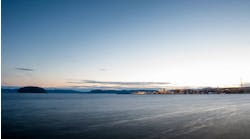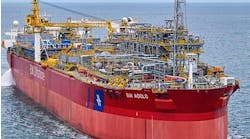Mike Coulthard,UWG Group
Abandoning and completely sealing a well for thousands of years is a complex operation that must be carried out eff-ectively while taking into consideration the associated risks.
UWG Group's first well abandonments were carried out on suspended mudline wells in the relatively shallow waters offshore the Southern North Sea, using a system devised to plug and abandon the wells from a diving support vessel (DSV). Since then, the company's capability has expanded to include diverless solutions for multi-annular wells in the harsh environments West of Shetland. UWG has also developed techniques for platform well abandonments in the North Sea that have been implemented on three North Sea platform abandonment projects. In addition, it has acquired a subsea lubricator system for live well abandonments or production enhancement interventions on live subsea wells.
Subsea suspended wells
Suspended mudline wells offshore were traditionally abandoned with a jackup drilling unit. UWG, however, devised a method of setting the plugs in the annuli and casings from a DSV using packers and perforating guns. The wells required a surface cement plug 500-ft below the mudline, with removal of the casings to 10-ft below mudline. After reviews and safety checks with operators and the UK Health and Safety Executive, the system was approved and the first abandonments took place.
The company has enhanced the system progressively for abandonment of wells that require cement in two annuli and the casing. The system has been also been extended to subsea wellheads, and the latest upgrade removes the need for divers, which generates further cost savings. To date, UWG has been involved in the abandonment of 50 subsea wells in the North Sea, ranging from shallow gas basins to the harsh environments to the Northern North Sea West of Shetland.
Another UWG service is the suspended well abandonment tool, which performs the operations required to install a 500-ft plug in up to two annuli. Operations include:
- Initial pressure testing
- Perforating, bleeding off annulus pressures, and circulating out drilling fluids to surface
- Circulating or squeezing cement plugs into place and pressure testing plugs.
All of these operations can be performed with a double barrier system in place while the vessel, connected by a flexible umbilical, moves around freely on the surface. This also makes the operation relatively weather robust. The time to abandon a well with cement plugs and sever the wellhead below the mud line averages two to three days, including transits. To reduce mobilization costs for well owners, UWG has coordinated campaigns, working with several operators and abandoning a multitude of wells simultaneously.
As part of its well abandonment package, the company provides an independently verified technical risk assessment of the well to ensure well risks and status are fully understood prior to intervention.
Platform abandonment
In 1999, UWG won a contract to abandon 23 wells on a large North Sea platform. UWG set up Platform Abandonment Combined Technologies, which represented Baker Oil Tools, Baker Atlas, PSL, Claxton Engineering, and Team Energy (the latter both UWG Group companies). PACT was able to offer a comprehensive package of abandonment services to clients, but it also provided project management and supervision throughout, working closely with the operator.
This project was also based on a rigless approach, which allowed the rig to recover electric submersible pumps while downhole plugging operations were carried out simultaneously.
The well abandonments were split into two phases. The first phase involved plugging and abandoning the wells with cement plugs, and the second involved severing the casings and recovering to the surface. To minimize the risk of environmental damage, all well fluids, including oil, gas, completion brine, and drilling fluids, were immediately re-injected into wells via the platform.
The wells were plugged with an initial cement squeeze into the formation to provide a pressure test base on which to set subsequent plugs. All plugs were installed through tubing. Once the squeeze plug was tested, the tubing was perforated on a slick line trigger system and subsequent plugs circulated into place into single and double annuli, each plug being verified with a pressure test.
The slick line perforating system allowed other platform abandonment operations to proceed without the requirement for radio silence. At the peak of plugging operations, three slickline units were working simultaneously with two cement units, one for cementing and the other for displacing well contents and pressure testing. In total, 82 cement plugs were installed and over 108 perforating and tubing cutting runs were made, in some instances with 10 well interventions in a 24-hour period. Wells took an average of 4.5 days each to abandon and 2,440 man-days were spent without lost time incidents or any environmental damage in a period of less than three months.
Once the final plug was installed and tested, the wells were monitored in the weeks following. The tubing was then cut and recovered without using the rig to give sufficient rat hole for the casing cutting. All the casing strings were perforated through to the outer annulus to confirm there was no pressure in the annuli.
The second phase of the well abandonment involved cutting and recovering the casing and conductor. The platform wells were mainly pre-drilled with subsea wellheads, which had a diameter greater than the platform guides, so the 30-in. housing could not be recovered back to surface. This would also make mechanical cutting a tedious and time consuming operation as individual tieback strings would have to be cut and recovered before recovering the casings.
In response, we developed an abrasive cutting system using high-pressure water and garnet to cut the multiple strings on the wells in one rotation. Initially, the contract was to cut above the subsea wellheads (9 5/8-in., 13 3/8-in., and 20-in.), leaving a DSV to recover the wellheads explosively after the platform had been removed. However, a delay in the platform float away date provided an opportunity to develop the system further to cut the wells below the mudline in a single pass. This involved cutting the additional 30-in. conductor.
The conductor strings were cemented and bound to the template and also locked into the 20 in. with a shear pin, so the verification pull on the cut had a number of consequences, depending on which was the weakest link:
- The shear pins and cement between the wellhead and the 30 in., in which case the wellhead came free and could be recovered to surface complete
- The cement between the 30 in. and the template, in which case the wellhead and 30 in. was laid back down and re-cut above the wellhead to allow recovery to surface.
Verification of the cut required a shock load-compensated jack, as pulling loads of up to 300 tons with the blocks raised safety concerns over a potential string failure. Claxton Engineering designed and built the jack, which was run in the rotary table and locked into the rig structure with a "strong back." The shock compensation system ensured minimal forces were exerted onto the platform so that the casings broke free from the template in a safe and controlled operation.
Rather than recovering one casing/conductor string at a time, all the concentric strings were recovered simultaneously and were pinned together to distribute the loads before being sliced into manageable sections with a band saw specially developed by UWG.
The technique reduced deck space requirements, saved time and manhandling, and proved to be highly effective and extremely safe. For example, some of the connectors on the 30-in. conductor, normally under compression in the splash zone, had corroded and had therefore lost their ability to hold tension. Had they been recovered separately they could have failed in tension and fallen to the seabed, potentially damaging the platform structure. However, since they were locked into each other, the strings were recovered safely.
In 2001, a platform in the Dutch North Sea was abandoned using a jackup since the platform had suffered collision damage and could not support any weight. We provided much of the casing recovery and severance systems for the project including:
- The crews and equipment for cutting and pinning the casings on surface to allow recovery of multiple casings strings in one operation
- Subsea diamond wire cutting systems for seabed severance of conductor high pressure riser cleaning equipment and crews
- The riser tensioning system on the rig to suit the variable riser outside diameters and the surface riser system and wellhead interface equipment.
UWG was also awarded the conductor severance and recovery contract on a North Sea TLP in 2002. The TLP conductors differ from most platforms in that the risers have no jacket support bracings. The plan is to sever wells below the mud line with Sabre, UWG's unique high pressure abrasive system, developed from lessons learned from the previous deepwater platform abandonment project.
The effect of water depth on abrasive cutting is critical and extensive tests have been carried out onshore to simulate the conditions on the TLP. This will be the deepest water in which multiple strings have been simultaneously cut, the current record being set by UWG's previous platform abandonment. Tests show the system is capable of penetrating the four casing strings, including the 30-in., in less than two minutes, with an estimated 360° cut time of three hours.
UWG has recently opened an office in the Gulf of Mexico, an area with a mature abandonment market and an abundance of technological knowledge and expertise. The company believes that there is potential for a two-way technology transfer, which will benefit both the North Sea and the Gulf of Mexico in future operations.




